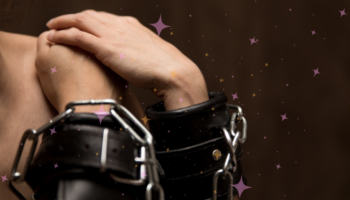One of the most common myths of bottoming for gay men also involves the most common reason that many gay couples can’t engage in it. The pain that some men experience with bottoming can keep many out of this arena for good. For relationships where this problem exists, frustration can ruin the relationship. However, it doesn’t have to be this way. There are ways to enjoy anal sex without experiencing any pain at all. If you really want it, and so does your partner, don’t throw your relationship away without processing through this workable problem.
For men who want to bottom, but the pain is too much for them, they can experience serious feelings of shame. One man might want to engage in this, but simply can’t. Sometimes, this can even make that person feel like a failure in the relationship. The couple might compare themselves to those who connect easily with anal sex in movies and even porn. Unfortunatley, movies don’t do a good job of depicting anal sex. They show it as something that should come easily. This isn’t always the case for couples; it can take a lot of effort to make it something that works for both of you. If your partner wants to bottom, but can’t, or if he even struggles with some anxiety of being penetrated, be careful not to shame him. Validate his feelings, and discuss this in an open way. This helps to build trust. Trust is critical for anal sex and for your relationship as well. (Get more tips in A First Timer's Guide to Anal Sex.) Fortunately, a lot of the fear and anxiety that surrounds anal sex is based on myth. Here we'll tackle some of the misconceptions that could be getting in the way of enjoying anal pleasure with your partner. The first myth involves labels. For many gay men, there are labels of being a “top” or “bottom.” These labels suggest that people inherently find pleasure in one position or the other. This can make it seem like there is nothing to work towards. If your positions are already determined, then your only option is to find someone whose position is compatible with yours. This is built on heteronormative ideas of gay relationships. People can enjoy one position, both positions, or have no strong desire either way, yet still engage in topping and bottoming. For some, this comes easy. For others, it’s more work. The next myth is about pain and anal sex. There is a serious lack of education surrounding pain and anal sex. People think pain is a natural part of anal sex. Despite this, we know that there are those who never experience pain with anal penetration. This is most likely because their body is open to receiving their partner’s penis. Does taking a penis sound intimidating to you? Then your body has some work to do. It needs practice settling into the sensations and psyche of being anally touched.
With greater understanding that pain is not normal or natural, you can enjoy bottoming. You can help your body associate anal penetration with pleasure. If you want this to be part of your sexual relationship, patience, understanding, and practice will be important in making it happen. (Learn more in Should We Talk About the Fact That Anal Sex Might Hurt? ) Before discussing pain-free anal sex, it’s important to note that bottoming isn’t for everyone. There are plenty of gay couples who enjoy play without any penetration. Oral sex, mutual masturbation, and other types of sexual play can be just as arousing and pleasurable. Even though anal sex is talked about like it’s the primary sexual activity for the majority of gay men, this isn’t really true. Be aware of your personal reasons for wanting anal sex. It’s important to recognize heteronormative pressures that make penetration seem like a necessity. “Gay culture” also can create an illusion that you’re somehow abnormal if you don’t want to engage in anal sex. Such feelings can lead you to put pressure on your partner without taking responsibility for your own awareness and arousal. You can have a healthy, connected relationship even if you, or your partner, have no desire for anal sex. Recognize your perspective, but respect your partner’s as well. Again, the key to sexual connection in long-term relationships is communication.
Despite what gay porn will often depict, it’s important to listen to what your body tells you when bottoming. How many porn clips have you watched where the man bottoming starts out in agonizing pain, and then magically moves toward sexual bliss? Although there are many who experience pain upon initial penetration, it doesn’t have to be this way. Pain is not normal, and shouldn’t just be tolerated with an expectation that it’ll turn into sexual pleasure. It’s the body’s signal to stop. Good anal sex is all about listening to your body. (Learn more about when to stop in Don't Have Anal Sex If ... )
Pain is not the way to go about making anal sex a solid part of your sexual relationship, especially for those where this has already been an issue. If you’ve had problems with pain in the past, your body isn’t going to be receptive to bottoming. If your partner has experienced pain and you don’t listen to this, his body isn’t going to be receptive. Anal sex is largely about trust. This trust isn't just in the mind, but in the body as well. This is one of the biggest reasons why anal sex hurts for some people. The sphincter muscles aren’t always receptive to things being inserted into the rectum. This, combined with the stigmas and shame we put on men who enjoy penetration, can make the pain even worse. The body must associate penetration with pleasure or, at least, safety.
If you're reading this and wondering how to help your partner, here's what you should know. Anal sex requires patience so that your partner’s body can adjust and learn to trust you. Getting rid of judgment and increasing your patience will be critical here. It will also help you to connect with your partner. When being patient with each other, you can practice touch and embodied trust. You can then apply this to taking steps toward penetration. Don’t jump into full-on anal sex right away. You both can practice dealing with the sensations of being anally touched. Start with a finger or a toy. Experiment with touch and sensation. Start by practicing minor amounts of insertion. Then just stop there until you are both ready to move forward. Make eye contact and breathe together. This can also help you connect and relax at the same time. It also takes the pressure off of penetration, and allows you both to enjoy the process of identifying pleasure and arousal in the body without focusing so heavily on orgasm. When there is no pain, you can proceed to gentle, slow, full insertion.
Breathing is integral for the man bottoming as well. Start with fully inserting a finger or the toy. This will help to keep things controlled, which is important. After using a lot of lubricant, gently insert the finger or toy. Regularly check in with each other. Remember, this is about embodying trust. If there is no pain, then great! If there is any pain, stop. For the partner bottoming, the sensation of the experience might take some getting used to. Be patient with this as well.
With ongoing gentle practice, you both will be able to proceed to inserting a penis. The first few times, you might want to begin with stimulation through the toy or finger, which will likely be associated more with safety and pleasure than before. This will help to ease the anal area into the next step. If there is pain, then go back and continue to work on rhythmic breathing. If pain continues, visit your primary care physician. There could be a fissure or hemorrhoids. If these are clear, you can also talk with a sex therapist or sexologist who can help you with better identification with your body using sex therapy strategies.





